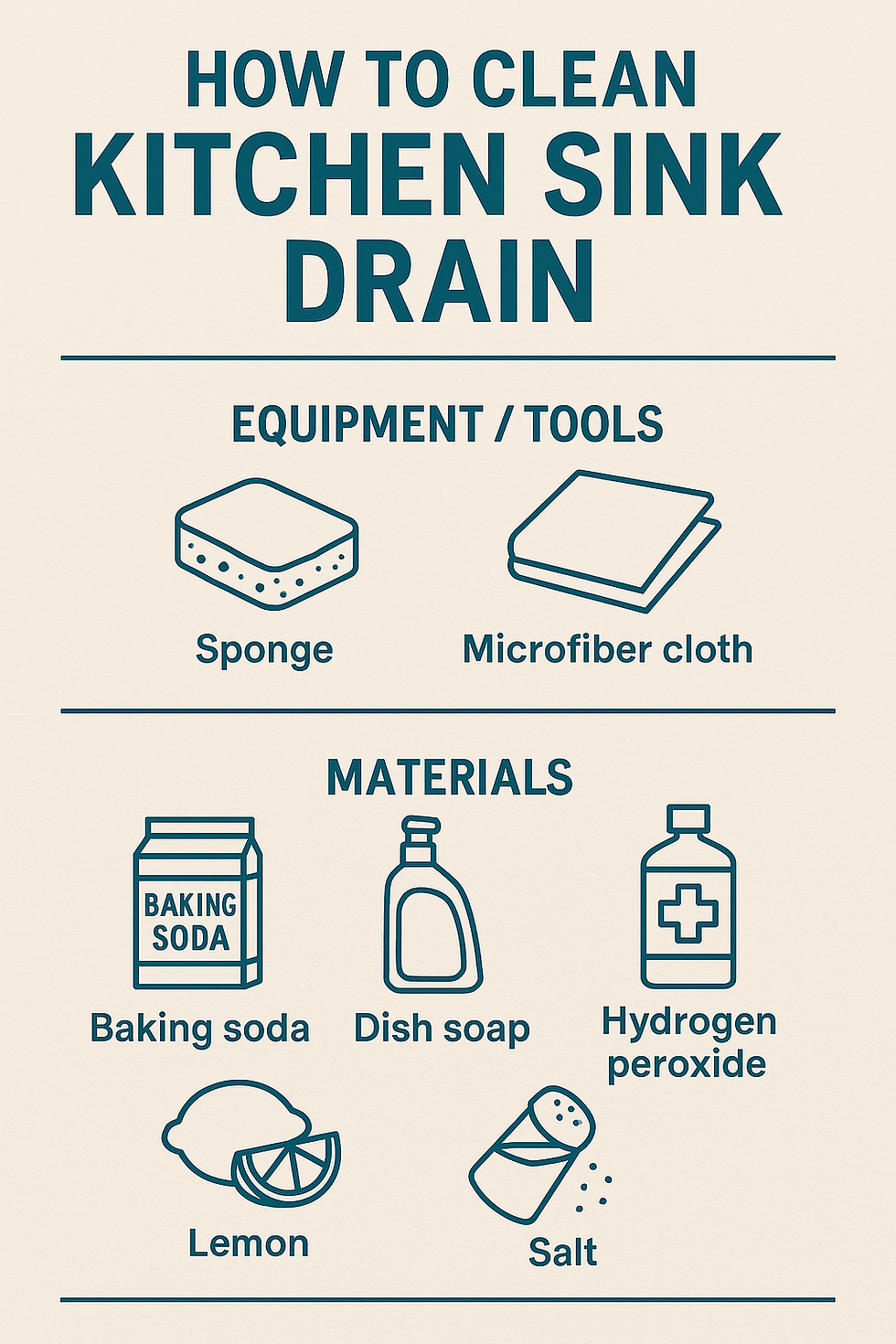How to Clean Kitchen Sink Drain
- Staff Desk
- Oct 28
- 4 min read

Your kitchen sink works hard every week — from washing burnt pots and pans to rinsing soil after watering plants. Over time, this can cause grime and buildup in the sink and drain.
Knowing how to clean your kitchen sink and drain helps stop dirt and bad smells from spreading around your home.
Give your sink some care by cleaning it once a week. Follow these easy steps to keep it shiny, fresh, and germ-free. Once you make it part of your weekly cleaning routine, your kitchen will always look and smell clean.
Before You Get Started
Before cleaning, clear your sink of everything — food bits, dishes, mugs, and racks.
Next, rinse the sink with water to wash away crumbs and loose dirt.
Put on rubber gloves to keep your hands safe and clean.
Remember, each sink type is different, so use the right cleaning method for your sink’s material — like stainless steel, porcelain, or granite.

Kitchen Sink Drain Cleaning Cost in the USA
Type of Service | Estimated Cost (USD) | Details | DIY Cost (USD) | Money-Saving Tips |
Basic sink drain unclogging | $100 – $220 | Simple clog near the drain or trap, quick 30–60 min fix | $5 – $15 | Try baking soda + vinegar first. Use a plunger before calling a plumber. |
Average professional unclogging | $250 – $400 | Medium clog deeper in the pipe, may need drain snake | $15 – $30 | Buy a small hand snake for future use—it’s a one-time cost. |
Heavy or complex drain cleaning | $400 – $600+ | Serious blockage, grease buildup, or multiple clogs | $30 – $50 | Regularly pour hot water + vinegar to prevent buildup. Avoid grease in sink. |
Instructions
How to Clean a Kitchen Sink
How to Clean a Stainless-Steel Sink
Stainless steel sinks are strong and long-lasting. They don’t stain or rust easily, unlike white or ceramic sinks. But they do have a few enemies — acidic foods, bleach, and rough scrubbers. These can damage the shiny finish of your sink.
To keep your sink looking good, don’t leave acidic foods like lemons or tomatoes in it for too long. Also, avoid bleach-based cleaners or harsh scrubbing pads.
Step 1: Apply Cleaner and Scrub
Wet the sink and sprinkle baking soda all over it. Add a few drops of dish soap and some hot water to your sponge.
Start scrubbing from the sides of the sink and move down toward the drain. This helps push all the dirt and grime down and out. Add more soap or water if needed until the sink looks clean and shiny.
Step 2: Rinse and Dry
Rinse the sink with clean water to remove any leftover soap.
Because stainless steel can show water spots, it’s best to wipe it dry with a soft microfiber cloth. This not only dries the sink but also gives it a nice shine and polish.
How to Clean a White Kitchen Sink
White kitchen sinks look bright and beautiful, but they can easily show rust, food stains, coffee, and wine marks. Luckily, a mix of baking soda and hydrogen peroxide can help remove stains and make your sink look new again.
Step 1: Apply Cleaner and Scrub
Dampen the sink with a wet cloth so the surface is slightly moist. Then, sprinkle baking soda all over the basin until it’s fully covered.
Next, add a few drops of hydrogen peroxide on top of the baking soda. Use a sponge or soft brush to gently scrub the surface. This mix will lift stains and bring back the sink’s brightness.
Step 2: Rinse and Dry
After cleaning, rinse everything down the drain with clean water. Then, wipe the sink dry using a soft cloth to prevent water spots and keep it looking spotless.
How to Clean a Porcelain Kitchen Sink
Porcelain sinks have a shiny, glossy finish that looks beautiful but can easily get rust spots and stains, just like white sinks. You can clean them the same way — using baking soda and hydrogen peroxide — but for rust, you’ll need a gentler method to protect the smooth surface.
Step 1: Treat Rust Stains
Cut a lemon in half and sprinkle salt on the cut side.Rub the lemon directly on the rust spots. The natural acid in the lemon and the roughness of the salt will help remove the rust without scratching the sink.
Step 2: Rinse and Dry
Once the rust is gone, wash the sink with warm, soapy water.Finally, wipe it dry with a soft microfiber cloth to keep the glossy finish shiny and spotless.
How to Clean a Sink Drain
Your kitchen should smell fresh and clean, not like old food or grease. If your sink drain has an unpleasant odor, don’t worry — you can fix it easily with a few things you already have at home: baking soda, white vinegar, and hot water.
Step 1: Pour the Mixture Down the Drain
Use a 1:2 ratio — that means one part baking soda and two parts white vinegar.
First, pour the baking soda into the drain. Then, slowly add the vinegar. You’ll see some fizzing and bubbling — that’s the mixture working to break down grease and odor-causing buildup. Let it sit for about 15 minutes.
Step 2: Add Boiling Water
After 15 minutes, pour boiling water down the drain to wash away leftover debris and odors.
This quick and easy method keeps your kitchen drain fresh, clean, and smelling good.
How to Clean Kitchen Sink Drain with Garbage Disposal

Frequently Asked Questions
How do you clean a kitchen faucet?
You can clean any type of faucet or handle with warm soapy water. Just dip a sponge or soft brush into the soapy water and wipe everything down. For small or tight areas, use an old toothbrush to scrub gently.If you notice white lime buildup, mix a spoonful of vinegar into the soapy water — it will help remove it easily and make your faucet shine.
How do you clean a kitchen garbage disposal?
Cleaning your garbage disposal is quick and easy. Put a few lemon wedges, a handful of coarse salt, and some ice cubes into the disposal.Turn on cold water and then switch on the disposal until all the ice is gone. The salt cleans the blades, the ice removes stuck grime, and the lemon leaves a fresh smell.



Comments